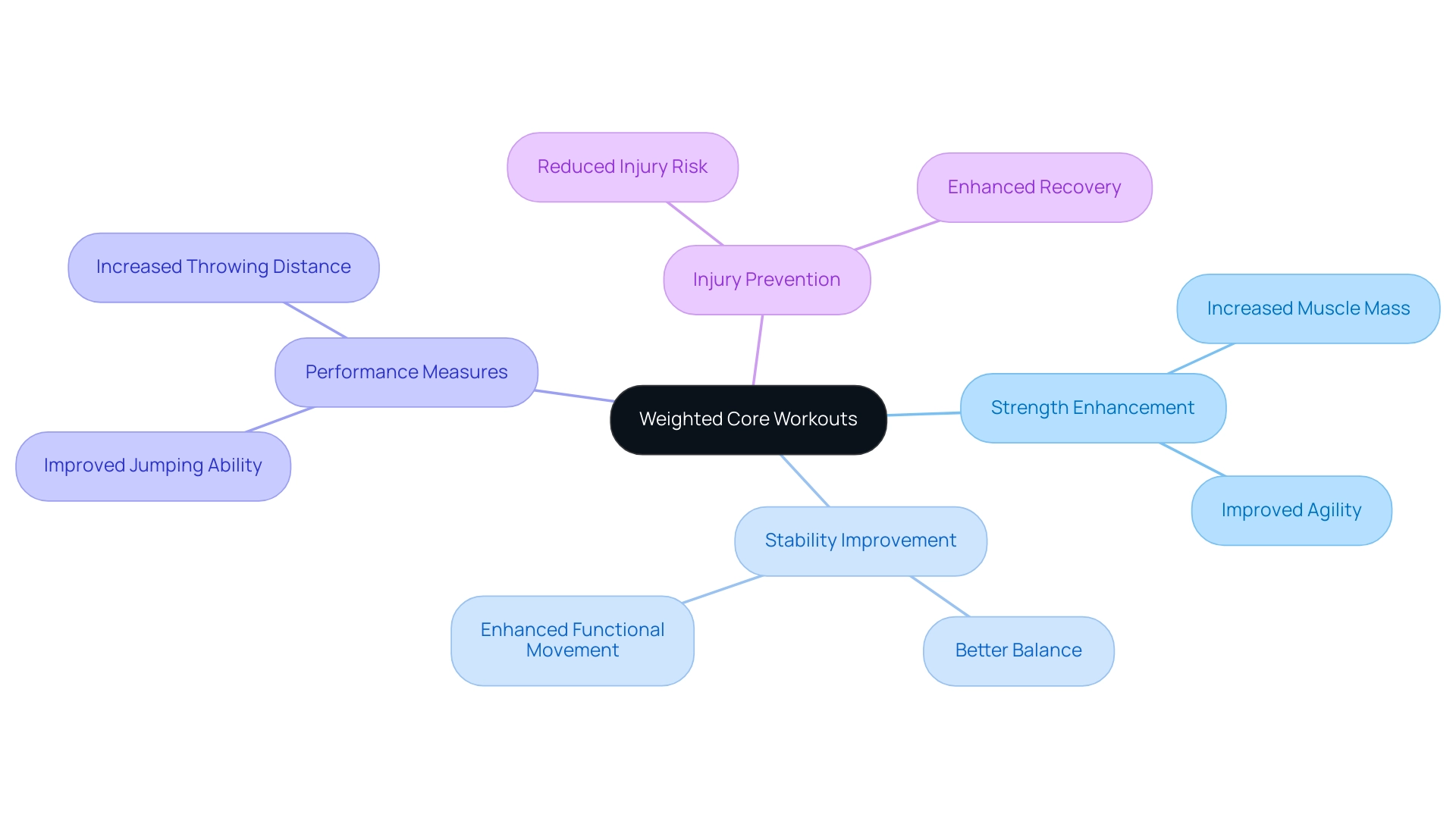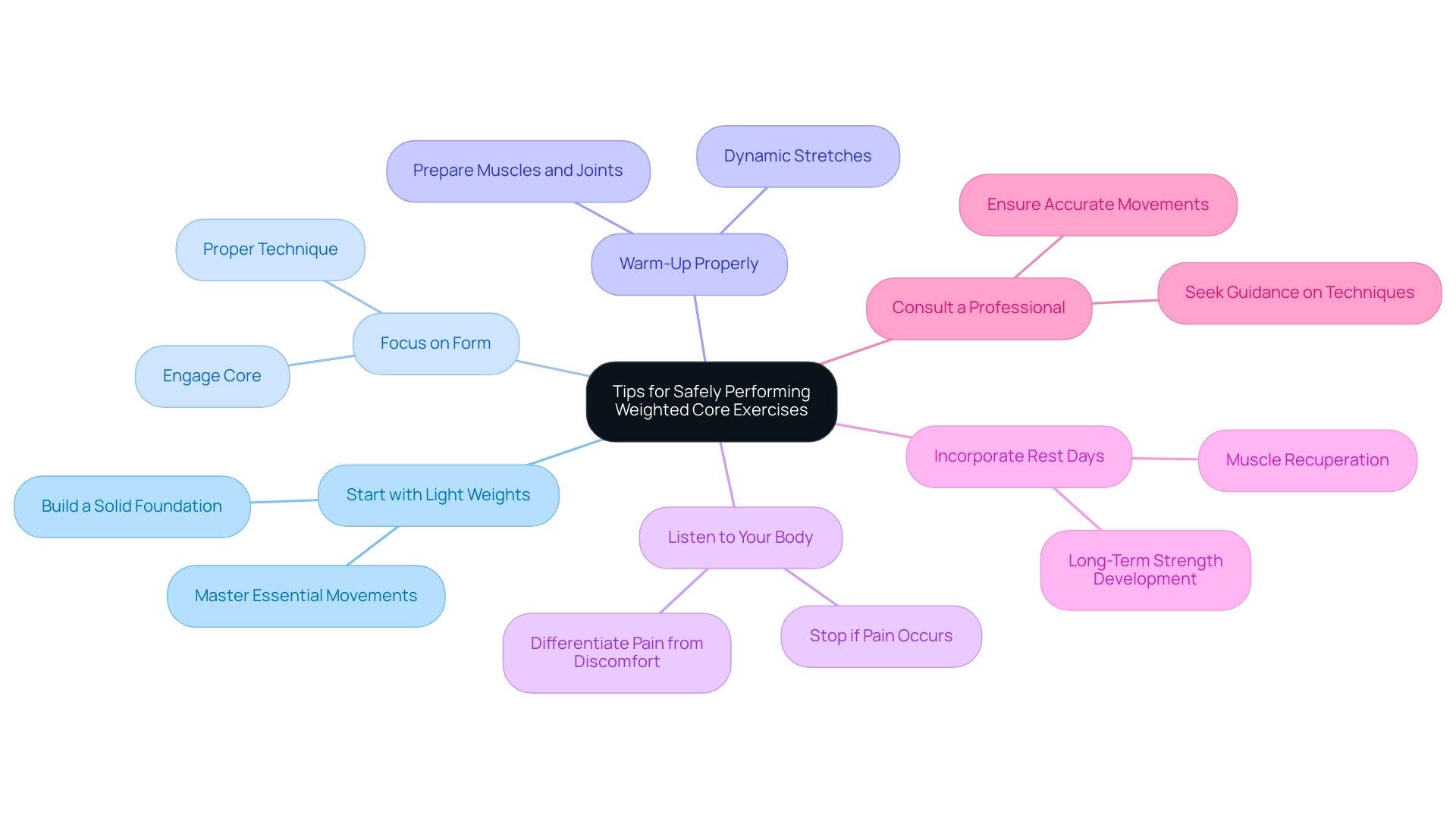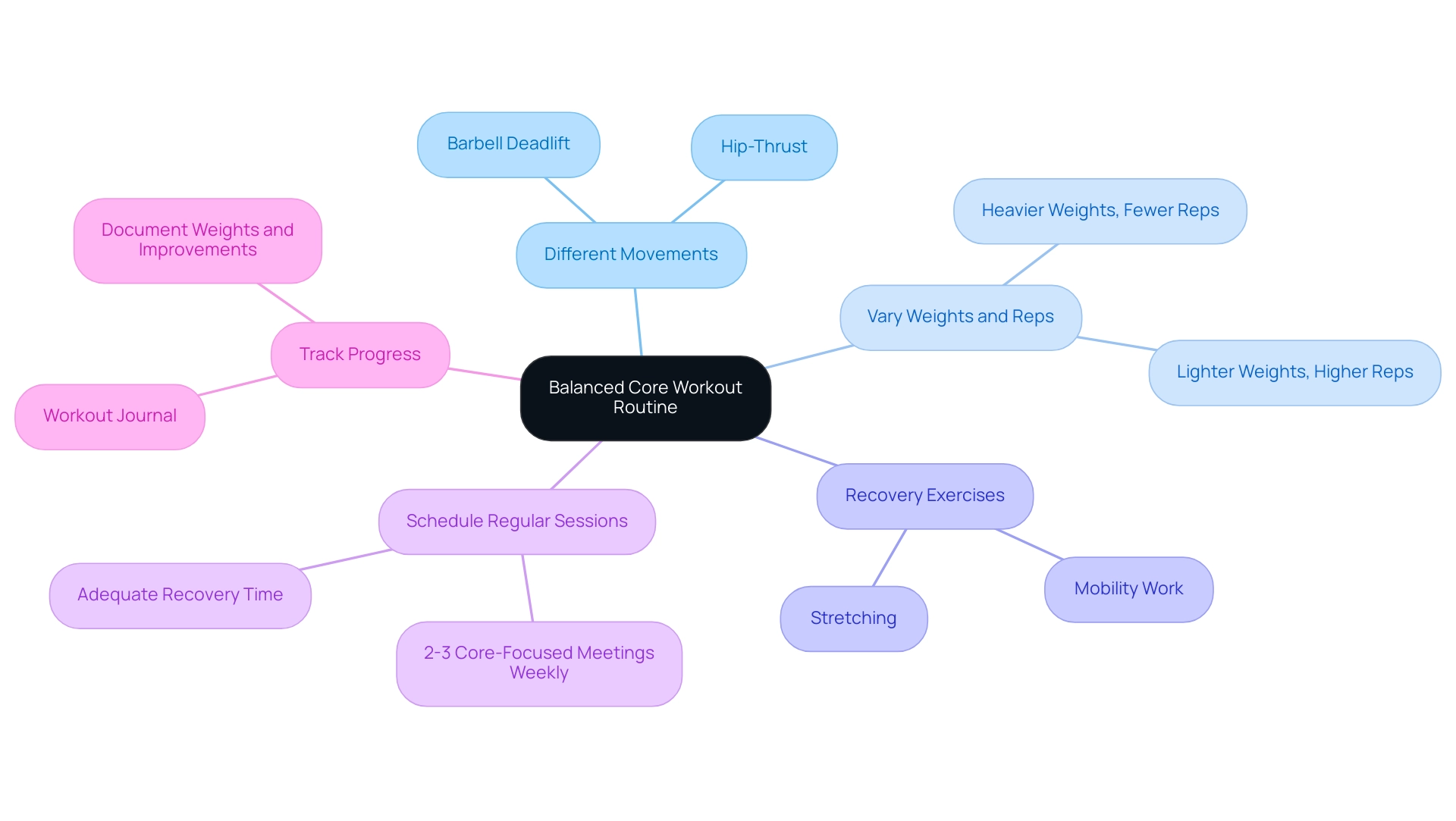Overview
The article focuses on the top core workouts with weights that maximize strength, emphasizing their importance for enhancing stability, athletic performance, and injury prevention. It supports this by detailing various weighted exercises that effectively engage core muscles, alongside research findings that demonstrate the benefits of these workouts in terms of muscle activation, caloric burn, and overall functional strength.
Introduction
In a world where fitness is not just a trend but a vital component of overall well-being, the significance of weighted core workouts cannot be overstated. These exercises serve as the backbone of strength training, enhancing not only physical stability but also athletic performance and daily functionality. By engaging in a variety of weighted core exercises, individuals can effectively target essential muscle groups, leading to improved endurance, better posture, and a reduced risk of injury.
As organizations increasingly recognize the importance of employee wellness, prioritizing these workouts can empower teams to embrace a healthier lifestyle and foster a culture of strength and resilience. With the right approach, incorporating weighted core routines can transform not just individual fitness journeys, but the collective well-being of an entire team.
The Importance of Weighted Core Workouts for Strength Building
Incorporating the best core workouts with weights into fitness routines is crucial for enhancing strength and stability, which are vital for optimal athletic performance and daily activities. Engaging in the best core workouts with weights allows individuals to effectively target their abdominal muscles, obliques, and lower back, leading to increased muscle mass and improved endurance. Recent studies indicate that central training can have a significant impact on agility, with a medium effect size observed (SMD = -0.54; 95% CI: -1.23–0.15), underscoring the importance of properly designed central training programs for improving sport-specific athletic performance.
As mentioned by Kuan Dong, Tenghao Yu, and Buongo Chun from Myongji University, 'These results suggest that it is necessary to adequately design essential training programs to improve sport-specific athletic performance.' Moreover, the best core workouts with weights not only improve balance and functional movement but also lower the likelihood of injury, making these exercises an essential component of any fitness routine. The case study titled 'Core Training and Athletic Performance' concluded that the best core workouts with weights have small to large effects on various performance measures, including balance and jumping, which reinforces the argument for prioritizing these exercises.
Adopting the best core workouts with weights not only strengthens individuals physically but also nurtures self-assurance, enabling them to confront more demanding training sessions with increased ease. By prioritizing these essential exercises, HR Benefits Managers can significantly contribute to their team's well-being and performance.

Top Weighted Exercises to Strengthen Your Core
Incorporating the best core workouts with weights into your workout regimen can significantly enhance both strength and stability. Research by McGill & Marshall (2012) indicates that particular activities can elicit substantial EMG activity, which is a measure of muscle engagement. Here are some top exercises that can energize your fitness regimen:
- Weighted Plank: Elevate the traditional plank by placing a weight plate on your back. This added resistance intensifies central engagement, making your muscles work harder and improving endurance.
- Dumbbell Russian Twists: While seated with your feet elevated, twist your torso from side to side while holding a dumbbell. This dynamic movement effectively targets the obliques, promoting rotational strength crucial for many sports.
- Medicine Ball Slams: Lift a medicine ball overhead and slam it down to the ground with force. This explosive exercise engages the center while also enhancing power and coordination.
- Barbell Rollouts: Kneel and roll a barbell forward, extending your body while keeping your abdomen engaged. Pull back to the start position to strengthen the entire abdominal region, including the rectus abdominis.
- Weighted Side Bends: Stand tall with a dumbbell in one hand and bend sideways at the waist. This targets the obliques and enhances lateral stability, essential for athletic performance.
- Dumbbell Dead Bug: Lie on your back with a dumbbell in each hand, alternating the extension of opposite arms and legs. This movement challenges your fundamental stability and coordination effectively.
- Weighted Sit-Ups: Perform traditional sit-ups while holding a weight plate or dumbbell against your chest. Adding resistance increases the intensity, fostering greater power gains.
- Cable Woodchoppers: Use a cable machine for rotational movements that focus on the midsection and enhance functional strength. These movements mimic real-life activities, improving overall performance.
- Kettlebell Turkish Get-Up: This total-body activity not only activates the midsection but also enhances stability and coordination. It’s an excellent addition for those looking to challenge themselves.
- Weighted Flutter Kicks: Incorporating a light weight between your feet while performing flutter kicks intensifies the challenge for your lower abs, resulting in a more effective workout.
Notably, the curl-up with hands behind the neck has been shown to elicit the greatest EMG activity, making it a benchmark for abdominal engagement. By incorporating the best core workouts with weights into your routine, you will not only improve your central stability but also enhance your overall fitness and well-being. Remember, as Eni Kadar, a physical therapist, wisely points out,
We're utilizing our central muscles in motion—while running, lifting, carrying, and playing sports that require speed and movement in the 3D plane.
Start small, focus on maintaining proper form, and progressively increase the weights as your strength improves. The benefits are well worth the effort!

Benefits of Incorporating Weights in Core Workouts
Integrating weights into fundamental routines reveals a wealth of advantages that can enhance your fitness program:
- Enhanced Muscle Activation: Weighted activities force your muscles to exert greater effort, leading to increased activation and growth compared to bodyweight routines. Recent research has indicated that hypertrophy grew considerably in machine-based training, with a standardized mean difference (SMD) of 0.206, demonstrating the effectiveness of resistance training.
- Enhanced Caloric Burn: The additional resistance not only intensifies the routine but also increases caloric expenditure during and after physical activity. This indicates your body keeps burning calories even after you've completed your session, maximizing the effect of each exercise.
- Best Core Workouts with Weights: Incorporating weighted abdominal routines into your fitness regimen mimics everyday actions, thereby improving your capacity to handle daily tasks with increased ease and efficiency. As Schwanbeck points out, activities like barbell back squats lead to higher myoelectrical activation in synergist muscles, which is essential for improving overall functional strength.
- Better Posture and Stability: Strengthening the core through weighted movements aids in improving posture, which can significantly reduce the risk of back pain and enhance overall stability. This stability is crucial for preserving proper form in various activities.
- Greater Variety and Challenge: Introducing weights allows for an expansive range of exercises and variations, keeping your routines dynamic and engaging. This variety can prevent exercise monotony and ignite motivation.
- Boosted Confidence: Witnessing tangible improvements in power and physical capabilities fosters confidence, encouraging individuals to continue their fitness journey with renewed vigor. Participants in the barbell-back squat group demonstrated significant reductions in body fat percentage without changes in body weight, showcasing the transformative potential of these workouts.
Additionally, a study by Wirth et al. (2016) involving 83 men compared free weight and machine training, highlighting that both methods increased strength but with different outcomes on body composition. Embrace the power of the best core workouts with weights and inspire your team to improve their health and fitness levels—it's a step toward a stronger, more confident future!

Tips for Safely Performing Weighted Core Exercises
To ensure safety while performing weighted abdominal workouts, it's vital to adopt the following strategies:
- Start with Light Weights: For those new to weighted activities, beginning with lighter weights allows you to master the essential movements and build a solid foundation before progressing to heavier loads.
- Focus on Form: The key to preventing injuries lies in proper technique. Maintain careful attention to body alignment and engage your core throughout each movement to maximize effectiveness and minimize risk.
- Warm-Up Properly: A comprehensive warm-up is crucial. Prepare your muscles and joints with dynamic stretches to reduce the likelihood of strains, enhancing your performance during the workout.
- Listen to Your Body: Always be attuned to how your body feels. If you feel any pain or discomfort, stop the activity immediately. It's crucial to differentiate between the usual discomfort from exertion and pain that may suggest injury.
- Incorporate Rest Days: Recovery is a vital part of any resistance training program. Scheduling rest days allows your muscles to recuperate, which is vital for long-term strength development and injury prevention.
- Consult a Professional: Should you have any uncertainties about specific exercises or techniques, don’t hesitate to seek guidance from a qualified fitness professional. Their expertise can help guarantee that you're performing movements accurately and securely.
As emphasized in studies, the relationship between trunk stability and injury risk is a significant area of attention. Significantly, a study by McGill & Marshall (2012) included participants aged 25.60 ± 3.40 years, emphasizing the importance of stability across various age groups. J.M.M.
The level of evidence of the included studies was mainly moderate, which suggests that more high-quality research is necessary to reduce the risk of bias and draw solid conclusions about central muscle activity. Furthermore, the article titled 'Neuromuscular Control and Injury Prediction' discusses how deficits in essential neuromuscular control are associated with a higher risk of knee injuries, particularly in female athletes. By following these expert tips, you position yourself and your team not only for a safer exercise experience but also for enhanced performance and well-being.

Creating a Balanced Core Workout Routine
To create a comprehensive routine that genuinely improves strength and stability, consider these essential components:
- Incorporate Different Movements: Diversify your activities to target various central aspects, including stability, rotation, and flexion. This variety not only engages different muscle groups but also helps prevent workout monotony. Notably, exercises like the barbell deadlift (~90% MVIC) and hip-thrust (~85% MVIC) are considered some of the best core workouts with weights, as they significantly activate abdominal muscles, making them excellent choices for your regimen.
- Vary Weights and Reps: Tailor your weights and repetitions to match your fitness level. Incorporating the best core workouts with weights, such as combining heavier weights with fewer repetitions alongside lighter weights for higher reps, can lead to optimal strength gains in the center of the body. As noted by fitness experts, this approach keeps the muscles challenged and promotes growth.
- Include Recovery Exercises: Integrate stretching and mobility work to enhance flexibility and mitigate tightness in the core and surrounding muscles. Recovery is essential for overall performance and injury prevention.
- Schedule Regular Sessions: Aim for 2-3 core-focused meetings weekly, ensuring you allow adequate recovery time between sessions. Consistency is key to achieving lasting results.
- Track Progress: Maintain a workout journal to monitor your progress, documenting weights used and improvements in form or endurance. Monitoring not only maintains motivation but also offers a gratifying feeling of achievement.
As Murphy aptly states, > They truly isolate the abs, and pop them straight out against the skin <, emphasizing the effectiveness of focused abdominal exercises. Furthermore, a study by Mayer et al (2002) demonstrated that both groups using the MedX machine significantly increased strength, indicating that various training methods can be effective. By implementing these strategies, you can foster a dynamic and effective core training environment that encourages continuous improvement and engagement among your team.

Conclusion
Incorporating weighted core workouts into fitness routines is essential for enhancing strength, stability, and overall well-being. These exercises not only engage key muscle groups but also significantly contribute to improved athletic performance and daily functionality. By focusing on exercises like:
- Weighted planks
- Dumbbell Russian twists
- Medicine ball slams
individuals can experience increased muscle activation and greater caloric burn, leading to tangible gains in strength and endurance.
The benefits extend beyond physical improvements; weighted core workouts foster better posture, enhance functional strength, and inspire confidence. As teams embrace these routines, they cultivate a culture of health and resilience that empowers members to tackle challenges more effectively. By prioritizing these workouts, organizations can play a pivotal role in enhancing employee wellness, ultimately leading to a more productive and engaged workforce.
To ensure safety and effectiveness, it is crucial to adopt proper techniques, start with lighter weights, and incorporate recovery strategies into workout routines. By creating a balanced and dynamic core training environment, teams can not only boost their physical capabilities but also foster a sense of community and support. Embracing the power of weighted core workouts is a step toward a stronger, healthier future for both individuals and organizations alike.
Frequently Asked Questions
Why are core workouts with weights important?
Core workouts with weights enhance strength and stability, which are vital for optimal athletic performance and daily activities. They effectively target abdominal muscles, obliques, and lower back, leading to increased muscle mass and improved endurance.
What impact do core workouts with weights have on athletic performance?
Recent studies indicate that core training can significantly improve agility and has a medium effect size on sport-specific athletic performance. Properly designed core training programs are essential for enhancing athletic performance.
What are some benefits of incorporating core workouts with weights?
Core workouts with weights improve balance, functional movement, and lower the likelihood of injury. They also boost physical strength and self-confidence, enabling individuals to tackle more demanding training sessions with ease.
Can you provide examples of effective core workouts with weights?
Yes, some effective core workouts with weights include: 1. Weighted Plank 2. Dumbbell Russian Twists 3. Medicine Ball Slams 4. Barbell Rollouts 5. Weighted Side Bends 6. Dumbbell Dead Bug 7. Weighted Sit-Ups 8. Cable Woodchoppers 9. Kettlebell Turkish Get-Up 10. Weighted Flutter Kicks.
What should one focus on when performing core workouts with weights?
It's important to maintain proper form while starting with lighter weights and progressively increasing the weights as strength improves. This approach ensures effective engagement of the core muscles and reduces the risk of injury.
How do core workouts with weights contribute to overall fitness?
By incorporating core workouts with weights into a routine, individuals can improve central stability, enhance overall fitness, and promote better well-being, making them a crucial component of any fitness regimen.

